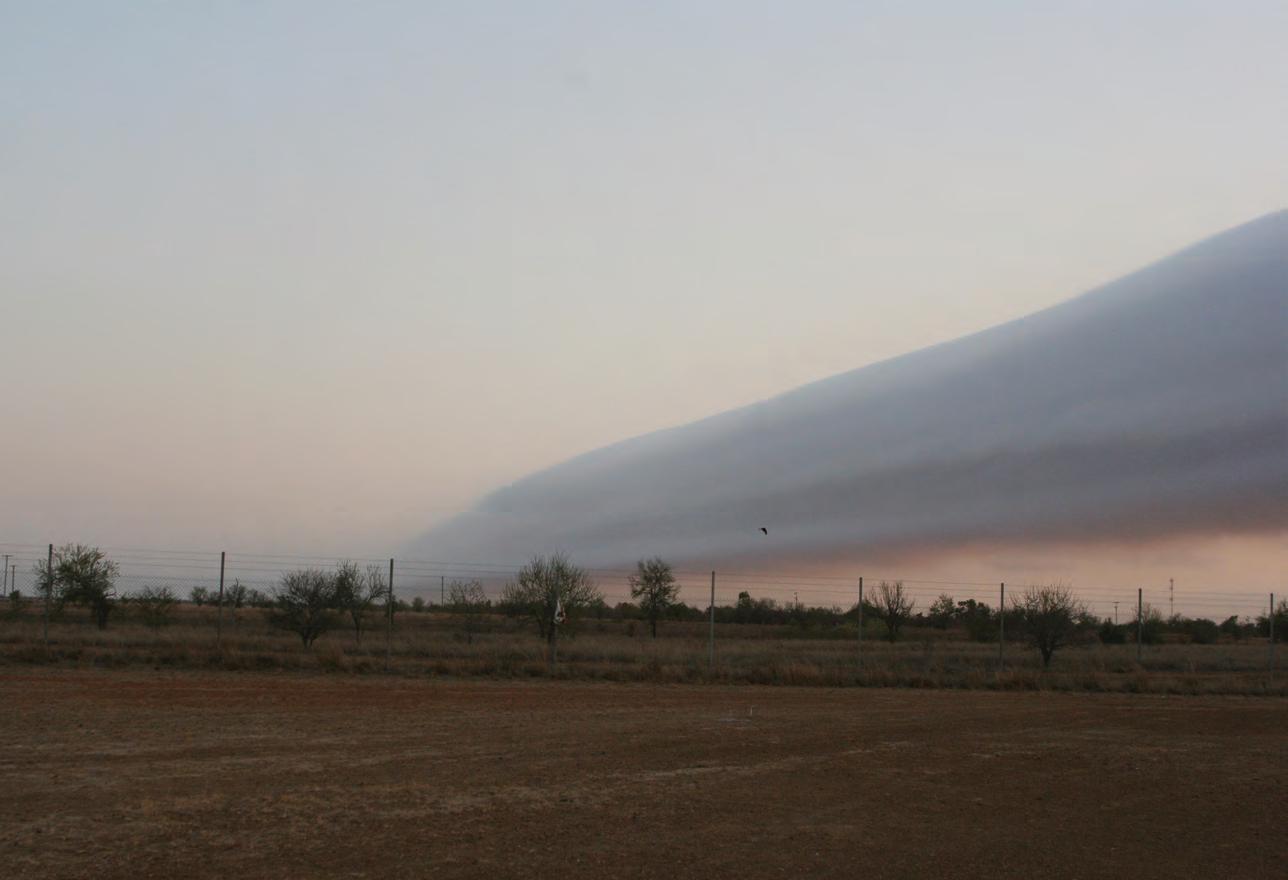
9 minute read
Flying the Glory
from SoaringNZ Issue 31
by mccawmedia
FLYING THE GLORY OCTOBER 2012 By Tony Tabart
The Morning Glory is an astonishing wave formation that appears in the early mornings, rolling in from the sea off the Gulf of Carpentaria, for only a few months of the year. Flying the Morning Glory has become more popular among glider pilots in recent years, but the effort required to get to Burketown, where the chance of a Glory happening are barely 50/50, make it an intrepid journey not attempted by many. Australian Tony Tabart has represented Australia multiple times at world championships (he was the fi rst Australian to win a day at a Worlds when he did so in Yugoslavia in 1972), been manager for Australian teams and helped out at the Worlds in Omarama in ’95. He is also a power pilot with an instrument rating and ran a small aviation business for some years. He has approx. 11,000 fl ying hours, both power and gliding. He completed building a Lancair (a high performance two-seater American kit) in 2005, which he owns with his partner Jo Pocklington. Tony has been fl ying for about 50 years and ‘the thrill is as great as ever.’ At 76 years of age, Tony has no plans to retire from the sport: ‘I’ll continue as long as I have my health and my ability; I’ll be fl ying as long as I can.’ Tony shares his adventures on this year’s Glory trip.
Advertisement
Photos Jo Pocklington
The Morning Glory has been on my bucket-list for quite some time. After seeing pictures and National Geographic articles, the Morning Glory became a defi nite must-do. We’d even taken our Lancair up to Burketown four years ago but it was late in the season and there was no Glory.
Ian Barraclough invited us to join his 2012, self-launching-glider safari and we jumped at the chance. There was a bit of a rush to fi nish the C of A on the Ventus 2cM, VH-VTT, and test fl y it, before putting it in the trailer for the trip north to St George to meet up with the group, mainly from Lake Keepit.
We launched from St George for the fi rst leg to Augathella; my partner Jo Pocklington was towing the trailer. Some arrived with diffi culty, others had engine starts. There were three motor gliders in the group, who travelled with the most confi dence each day, three self launching gliders and two power planes. Next day, all made it to Longreach - a blue day and not great soaring conditions. The Albert Park Motor Inn kindly supplied a bus for our use to and from the airfi eld.
We headed off, hopeful of the possibility of reaching Cloncurry, 540km north. Only the motor gliders made it. Predicted high cloud moved in and cut off conditions north of Winton. Jo made it to Cloncurry with the trailer, but I turned back 100km north of Winton, landing back on the airfi eld there as it was impossible to safely proceed further. John Clark in his DG800 and Ian and Geoff Sim in their two-seater ASH also landed at Winton. We parked on a grassed area behind markers, but were asked by council staff not to do so again.
No phone signals meant no contact with Jo to stop her proceeding, so she had to drive back the next morning, 350km from Cloncurry, to meet up with me. A night of heavy rain resulted in poor soaring conditions, so we put VTT in the trailer at Winton

and enjoyed a night at the Blue Heeler pub in Kynuna, en-route to Burketown, where we met up with the group once again and hoped to get a chance at riding a Glory.
A quick re-rig that evening and we were ready for action the next morning, even though conditions did not look favourable for a Morning Glory – dry south-easterly breeze instead of a moist northerly, which brings in a layer of moisture from the Gulf. Even though we were up well before dawn every morning, conditions remained unlikely for a Glory for the next three days. On the fourth morning, driving out to the aerodrome in the dark, picking up some of the other crew, a pre-dawn Glory went through like a minitornado, but it appeared to be dry.
On the fi nal morning of our stay in Burketown, determined not to be beaten by a pre-dawn Glory again, we were up even earlier, to be ready for launch at the fi rst glimmer of dawn. On arrival at the airfi eld we discovered a very heavy dew layer on the wings; a good sign of a possible Glory.
A litany of errors, including aerodrome lights blinking (which meant 10 minutes before switch off), made me rush my checks (stupid!) On take-off and just airborne, the brakes snapped open with a bang and in my rush to slam them closed, I bumped the fl aps to full negative, putting me fi rmly back towards the ground. The over-centre of the brakes was too heavy to allow me to close with one hand, and I was too close to the ground to let the stick go and pull on fl aps or close the brakes with two hands, so I had to persist
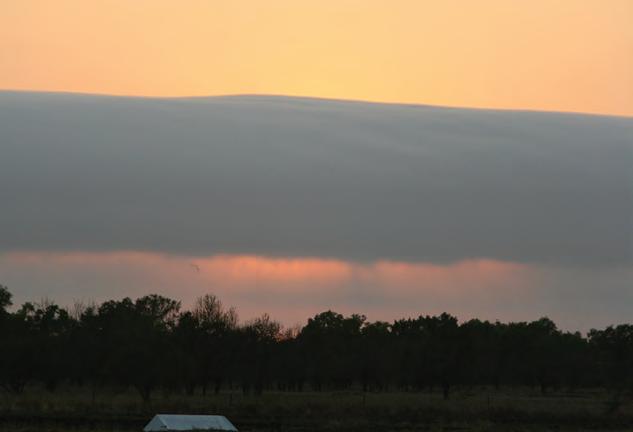
with the take-off at a higher speed.
Suddenly, at about 30ft, everything went black and I realised that the outside of the canopy had fogged over. Maintaining vision through the clear-vision panel, I could see refl ections in the river ahead of me, so started a gentle left-hand turn to get the aerodrome back in sight. At a safe height, I was able to take my hands off the stick, lock brakes and reset fl aps. I continued my climb to the northwest in the dawn gloom without being able to see the coastline of the Gulf, or any sign of the Glory.
As I climbed higher and gained more vertical visibility, a grey monster appeared on my right. It appeared to be 40km away and at that distance, looked stationary. At 2,500 ft I turned towards it and shut down the engine. At that point, I could see that the cloud was moving towards me. Flying straight at it from about two kilometres in front, everything went deathly quiet, except the vario which started beeping in an increasingly rapid tone, indicating strong lift.
I was the only one in the air. I radioed back to the ground: there is a roll cloud.
At the top of the Glory my height had reached about 4,000 ft, and I was met with a most incredible sight, but I was the only one lucky enough to see it. The sun was just appearing as a glowing red ball through a smoke haze, as is common at that time of year in that part of the country. As it increased in height, the glowing red rays of the sun reached the top of the Glory and slowly descended down the back edge, the trailing edge, until the whole of the back edge
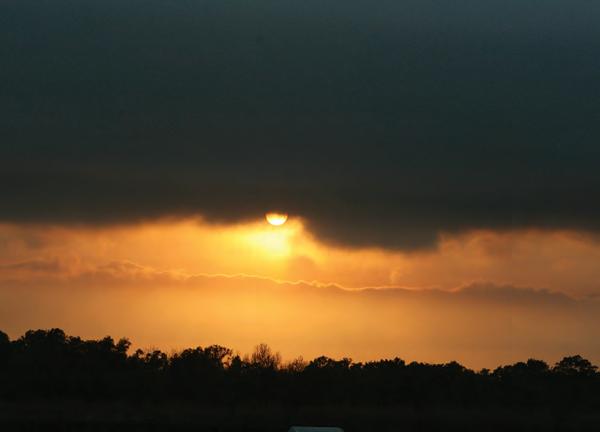
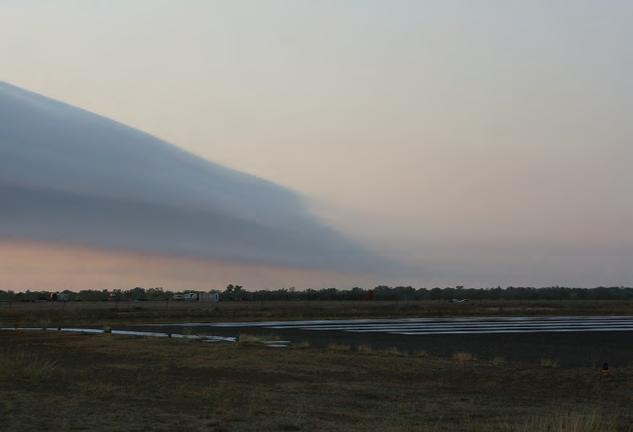
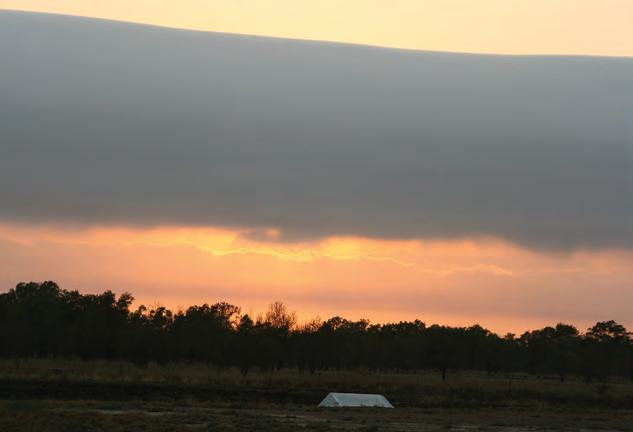
of the cloud was lit fl aming red and appeared like burning water, tumbling down over cobblestone rapids. It was the most amazing sight, but I didn't have a camera!
Flying high above the cloud and heading north-west out to sea, a secondary wave cloud became more and more evident (about eight kilometres further back) and appeared to be converging with the primary, perhaps 20-30km ahead of me. Conditions were still unusually smooth and quiet, even for wave – not a bump.
Then, at the convergence point between the primary and secondary, there appeared to be total cloud cover, with great lumps of cloud being ripped upwards and illuminated by the red morning sun. As I reached the convergence area, I felt the fi rst violent bumps of this turmoil, as if explosions were going off underneath me. This was very different from any turbulence I'd ever felt in gliding.
Not knowing how far out to sea I was, and being cautious, I turned south-east to run back along the cloud. Pushing the speed up to 130-knots in smooth air and sliding down the front of the cloud, still in unusual silence, I got to the point where the left wing tip started to slice into the clean-cut cloud. It looked like a knife slicing into thick whipped cream as it disappeared from sight. The impression was that it looked so solid that I would feel drag on that wing tip, and I found myself pushing on the right rudder to prevent it from dragging me in. But, of course, there was actually no change in resistance on the left tip.
At that point, I realised that the cloud had almost reached

Burketown as I could see over the leading edge, so I continued further south-east for about 30km and then turned back. The cloud had travelled quite a long way inland and over rough country to the south of Escott Station. Not having arranged with Jo and the trailer to go a long distance inland, I started to work out how to get back over the top. Slowing down to 60-knots, climbing above the cloud was easy. Diving off the trailing edge, through heavy sink and across to the secondary was no problem. A short fl ight on the secondary and feeling quite drained and tired with the adrenalin, I landed back at Burketown after about 90 minutes in the air. Words cannot describe the experience.
With a 350km fl ight back to Cloncurry that afternoon, I was very weary at the end of the day. There were four cross-country legs en route to Cunnamulla, where we encountered storms. Even though I arrived at 13,000 ft and could have reached Bourke, Jo had had enough driving for the day and we put VTT in the trailer the next morning. This was the right choice, as soaring conditions would have been very poor for the rest of the trip home to Western Victoria.
It's a huge trip from Western Victoria to the Gulf of Carpentaria: 6,000km return and an extra 700km to come back and get me from Winton. Would I do it again? Yes – if it were closer.

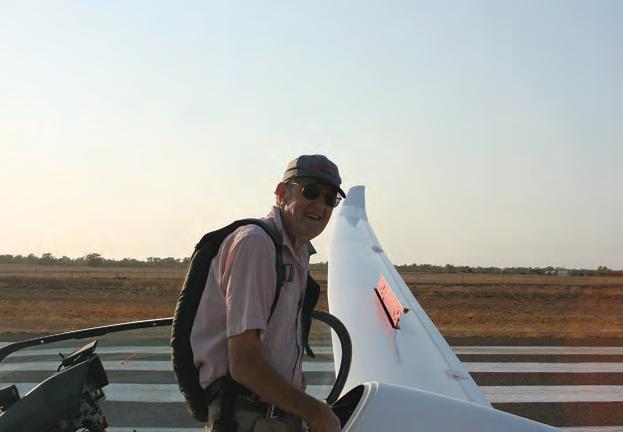
Derek Kraak's fl aming paint job helps him go faster. Derek had a really good contest at the Sth Island Regionals.



Geoff Soper Photo










